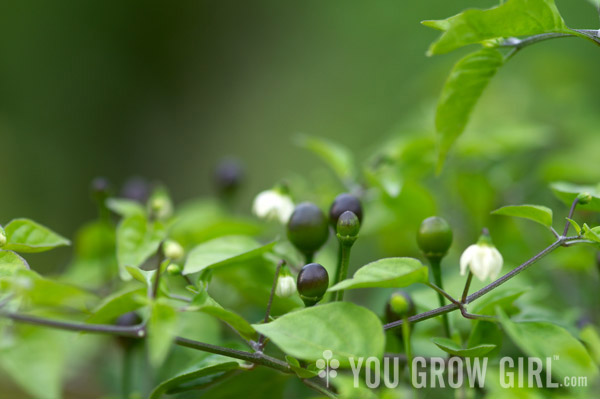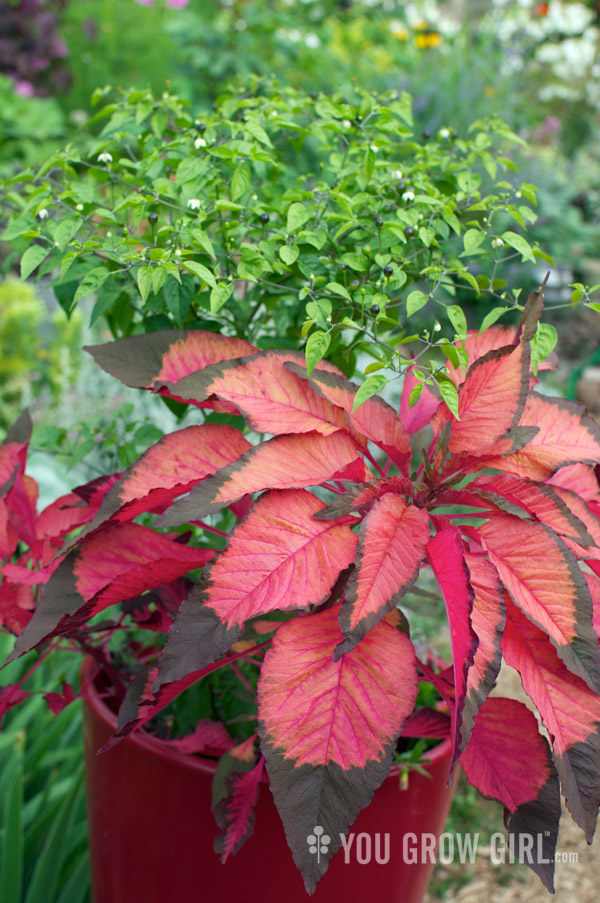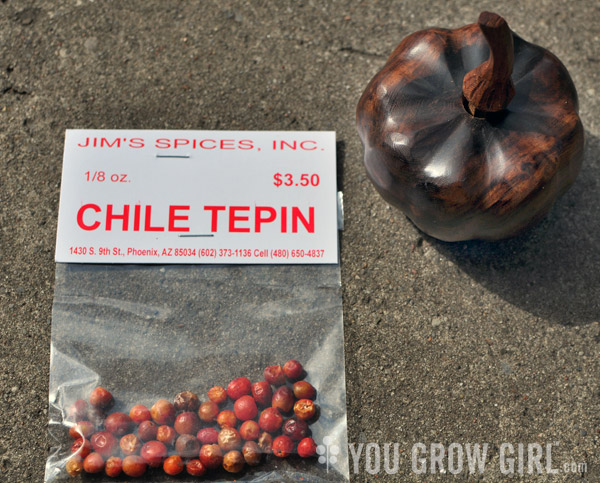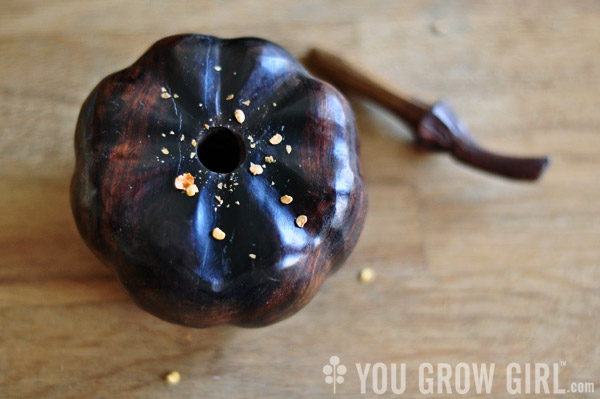
Chiltepin (Capsicum annuum var. glabriusculum) aka (Capsicum annum var. aviculare) or bird pepper is a small, pea-sized chile that grows wild on 3-4 ft-tall shrubs in parts of Texas and Northern Mexico. Coming in at 50,000-100,000 Scoville Heat Units (SHU), this pepper is ferociously hot and pungently flavoured. The heat comes on violently, yet diminishes rapidly, a trait that I suspect adds to its distinction as a much-loved and addictive delicacy.

My first chiltepin in August 2011. I grew it in a very large and deep pot alongside a ‘Molten Fire’ amaranth (Amaranthus caudatus).
I first grew this hot pepper in 2011 from a plant that I bought for $.50 in a late-season sale. I was intrigued by the name, and I will admit chose it because it was still quite healthy despite having spent the first few months of its life in a tiny cell pack. It was a hot year, but a late start did not hinder the plant from producing fruit before the first frost. The plant was so pretty that I clipped it off after the frost and used it in a fall floral arrangement. That arrangement is long gone, but I dried the Chiltepin plant and still have it [see photo below]. I love the look of the dried fruit set against the naked gnarled branches.
In early 2013 I was motivated by our forthcoming desert road trip to give the little pepper another go. I had just read more about the plant’s history in Gary Paul Nabhan’s book, Gathering the Desert, and was further inspired by its fascinating story and importance to the Papago people. Chiltepin is considered to be the wild mother of most of the cultivated chiles that you know and love. It is this fact that has drawn me back to keep growing it, even though I can’t comfortably eat the fruits of my labour. If you’re interested in birds, I think you’ll enjoy the portion of this chapter in Gathering the Desert that goes into the mutually beneficial relationship between this wild pepper and birds.
I grew this second plant from seed I had saved from the plant grown in 2011. Unfortunately, due to an unseasonably cold and wet year, the plant was slow to size up and did not produce a single fruit. I brought it inside before the hard frost and am over-wintering it in my kitchen (more on that experience later). I am hoping that 2014 is more amendable to my heat-loving plants and that this will be its year to shine.

A bag of dried chiltepines that I bought in the impulse-buy section of a gas station outside Phoenix, Arizona. What is virtually unknown here in Toronto, Canada was often spotted in Arizona. Right: The ironwood chiltepin grinder that I bought at the Native Seeds/SEARCH store in Tucson, AZ.
On the Tucson portion of our desert road trip we visited Native Seed/SEARCH, a nonprofit native seeds conservation organization and store. I loved the store so much that we went back a second time! I was absolutely thrilled to discover several more varieties of Chiltepin. I bought three, but since I don’t have the space to isolate them from one another, I have chosen ‘Amarillo’, a variety with golden yellow fruit as my second variety in 2014. I started the seeds underneath lights just last night.

While at the store I also discovered and bought this fabulous, carved tomato (it could also be a pumpkin) chiltepin grinder. It’s made of ironwood, which is exceptionally weighty for its size. They sell all shapes in the shop, but online I have only been able to find this whale-tale version. The mortar portion of the grinder is very small, just enough for a few chiles. You place them inside and then smash with the small tomato stem, which acts as the pestle portion. Chiltepines are far too hot for my sensitive gut, but I still had to have this beautiful kitchen implement! It’s a work of art and I keep it on my kitchen island where I can gaze upon it every day.

The dried remains of the chiltepin plant that I grew in 2011.
The Details:
- Open-pollinated
- Prefers a long, hot and dry season.
- Grow in well-draining soil. Allow the top inch of soil to dry slightly between waterings. In wet climates it helps to grow in a large container.
- Prefers shade when grown in a very hot climate and is typically grown underneath a taller bush or tree for coverage. In a cooler climate with less intense sun and a lower elevation, I find that it doesn’t require the same protection.
- Plants are tough and seem to be quite pest and resistance. I am yet to experience any issues with the plants I have grown and my indoor plant has been completely aphid-free this winter.
- Requires about 90-120 days to fruit. In cooler climates with a shorter growing season, start seed earlier than other hot peppers.
- Save seed from ripe, unblemished fruit.
- Fruit starts out green and ripens to red. However, this varies depending on the variety.
- Scarify (scratch or soak) the seed to aid germination.
- Peppers are very small (pea-sized) and hot to the tongue. Thin-skinned with lots of seeds.
- Container Growing: I recommend a pot that is at least 12 deep, if not deeper.
- Overwinter indoors. I have found that mine does not require the same light intensity as my tropical peppers. Bring indoors well before the hard frost hits your region and return outside in late spring/early summer once risk of frost has passed.
- May be propagated by cuttings.
———–
Disclosure: Please note that there is an Amazon link on this page, which when clicked on and used to buy an item, earns me a small commission. These funds are put towards purchasing books as giveaway prizes and make a small contribution towards the costs incurred to keep this site afloat. Please see my current Publication Policy for more info.
I’m definitely curious on how similiar it is to chile pequin, which is C. annuum, no variety. Wildflower.org has them as being quite similar, particularly in the common name sector. I’ll have to check it out more in depth later. I have seen the species growing wild here outside of Houston and it is generally available in local nurseries here. In fact, I just bought one for our flower bed! Not sure if I’m daring enough to eat it yet.
Flavour-wise I wouldn’t say they are interchangeable and the chiltepines are hotter, but they are closely related.
I love its slightly exotic look. Not sure I’m man enough to eat one though!
I bet you could. the heat dissipates really quickly. I can’t eat hot peppers but I taste test everything I grow so that I know how to describe them in my writings. I’ve tasted chiltepines quite a few times — the fieriness is temporary.
Here in Grenada we have the C. annuum – bird’s eye peppers which have been grown here since the slave trade. It is very hot with lots of flavour . I make a tasty pepper sauce with them or add them to soups. I find using the green peppers is much easier of the stomach. There’re also great when dried.
Wow! So happy and surprised to see this post! Chiltepin peppers are a family favorite that we hold near and dear to our hearts. Lots of funny stories of accidental exposure to these little suckers. Any ideas on where I can find a chiltepin plant in the LA area? Thanks so much for the info:)
I live in Toronto, Canada so can’t help you source plants, but perhaps someone else reading can.